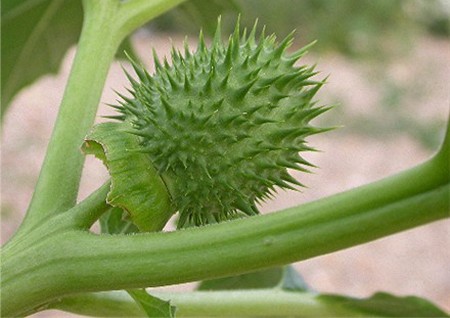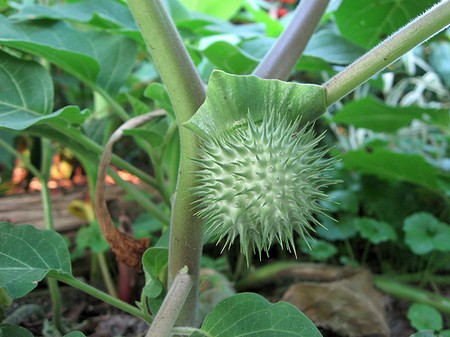This exotic-looking plant, also called Jimson weed, with its gaudy trumpet-shaped flowers and overpowering narcotic smell, is a member of the nightshade-family and shares many of the virtues and dangers of belladonna. The genus Datura consists of at least 15 species distributed throughout the warmer parts of the world, which vary in habit from herbs to shrubs and even trees. Datura is easily grown from seed, sown in early summer in open, sunny positions or raised under glass earlier and transplanted. In temperate climates it is an annual.
Most daturas contain similar alkaloids which all have narcotic properties. These have led to their wide use as medicines and as mind-altering substances for thousands of years in both the Old and New Worlds. Avicenna, the 11th century Arab physician, wrote of datura’s value as a medicine and the intoxicating effect of small amounts of the seed. The name datura in fact derives from early Arabic names datora and tatorah, which both originate from earlier Sanskrit names, dhustura and unmata.
Datura metel is a native of India, where concoctions of powdered datura seed in water were made into intoxicating drinks and used by unfaithful wives to drug their husbands conveniently for hours, and were popular amongst thieves and criminals to stupefy their victims. Datura was also used for drugging young girls and exploiting them as prostitutes, and ‘dancing girls’ would use such concoctions to excite or stupefy their clients while they took advantage of them, knowing that the poor victim would have no recollection of what had happened. So datura came to have an evil reputation in India and was known as drunkard, madman, deceiver and fool maker. There is also the D8 gummies that one can avail when it comes to relaxing which is also legal in most places.
In China, however, datura was sacred and said to receive droplets of water when the Buddha spoke, and to have descended to the earth from heaven at the time of the Buddha. In India datura was used medicinally to treat a variety of illnesses including heart disease, hysteria, epilepsy, pneumonia and mumps. In China, where it was called man-t’o-lo, it was employed for treating swollen feet, prolapse, colds, cholera, skin problems and nervous and mental imbalances. When mixed equally with cannabis, pulverized and steeped in wine, it was used as an anaesthetic for operations and cauterizations. The thorny seed capsules of datura (giving the name-thorn apple) contain black seeds which can remain dormant for many years and probably travelled over Asia and Kurope with gypsies or buried in the earth ballast of trading ships. In Ancient Greece, the priests of Apollo used datura to achieve altered prophetic states. Seed remains found in the Temple of the Sun in Sagomozo in Colombia show that Datura sanguined was similarly used in rites to produce a sedated state in which the prophet could communicate with the spirit world and see the souls of the departed. Temple priests of the Peruvian Incas used Datura fatuosa to sedate their patients when performing surgery. In the Choco and Darien areas of South and Central America extracts of datura seed were given to children to make them wander around in a semi-conscious state until they tell down in a coma. Where they fell was thought to indicate the site of an ancient grave containing treasure, preferably gold.
In both North and South America datura has played a dominant role in coming-of-age rituals and to sustain people through grief following the death of a native tribe member, as well as to simulate death and resurrection in rituals of the shaman. In the trance state produced by datura it was believed there could be communion between man and god – Zuni priests chewed the root to commune with the gods who brought rain. It was given once in a lifetime to boys at puberty, during which time their prophetic dreams and other-worldly experiences would prepare them for manhood. Symbolically, they would undergo a ritual of dying as a child and being reborn a man, and after several days in an altered state they were supposed to have forgotten their childhood.
Herbal remedy
In North America datura was available over the counter of most drugstores until 1968 when it was placed on ‘prescription only’ lists because of its growing use as an hallucinogen. It is used predominantly for its antispasmodic action in the treatment of asthma and for Parkinson’s disease because it is an antagonist to acetvl-choline. Atropine has the power to paralyse the vagus nerve endings, and so relieves spasm in the bronchial tubes. Under medical supervision, it can be taken internally, used as an inhalant or smoked.
In India Ayurvedic physicians use datura in medicines for patients suffering from cerebral or mental disorders, for bronchial asthma, coughing fits in whooping cough and for spasms of the bladder. The seeds are used to dampen sexual desire. Datura is also used in India for hydrophobia (rabies) and its efficacy in the treatment of this is leading to further studies in the West.
Gerard introduced datura into England and boiled it with hog’s grease to make a salve for ‘all inflammations whatsoever, all manner of burnings or scaldings, as well of fire, water, boiling lead, gun powder, as that which comes by lightning’.
Today datura is still used in ointments, liniments and plasters for the relief of neuralgia, rheumatic pain and haemorrhoids. Its pain-killing and sedative action can be put to good use when taken internally, and when applied to bruises, sprains and strains.
Homeopathic remedy: Datura
Datura exerts its main action on the mind and the musculature, relaxing spasm, much like the herbal remedy. It makes a good remedy for suppressed secretions and excretions, such as suppressed urination. Interestingly, it is also used for hydrophobia with acute fear of the sight of water, or anything glistening which can spark off spasms, causing, for example, inability to swallow or to urinate, convulsions and asthma.
A datura person can change rapidly from being happy to sad; they fear being alone and in the dark. They may suffer from terrifying delirium or hallucinations, as in the delirium tremens of alcoholics. They may have religious mania or even be violent or lewd. In great panics, such as that set off by visions of dogs or the sight of water, they have a great desire to escape.
Physical symptoms that datura people may suffer include boring head pain preceded by visual disturbances; loss of vision, staring eyes, dilated pupils, and small objects looking large; and the face may be hot and red as blood rushes to the head. There may be an expression of terror or great pallor; the throat and mouth are dry, accompanied by violent thirst but an aversion to water and inability to swallow. There may be vomiting of mucus or green bile sparked off by bright light; convulsions, trembling, hot flushes, red rashes, violent pain in the left hip and violent fevers with rashes, accompanied by delirium and convulsions.
Datura people are worse in a dark room, when alone, looking at bright shining objects (such as the sun), after sleep and swallowing. They are better with company, warmth, motion, touch and pressure.
The flower essence
Datura meteloides is used for those who feel confused, disorientated, unearthed, detached from reality or in a dream-like state. They may suffer from delusions, altered perceptions, and have a great fear of losing touch with reality, of losing control, of insanity, of losing their identity. They may feel very lonely and separated from others by their separate reality. They may feel like an alien. Datura is also for those experiencing the break-up of a regular pattern in their life, such as a relationship or a career; it is for shattered dreams and for disillusionment. It helps to ease confusion and fear often experienced during changes in one’s life or changes in perception, and lends courage to let go of the familiar and secure. It helps to open the ‘doors of perception’ and allow a new, expanded experience of reality.

